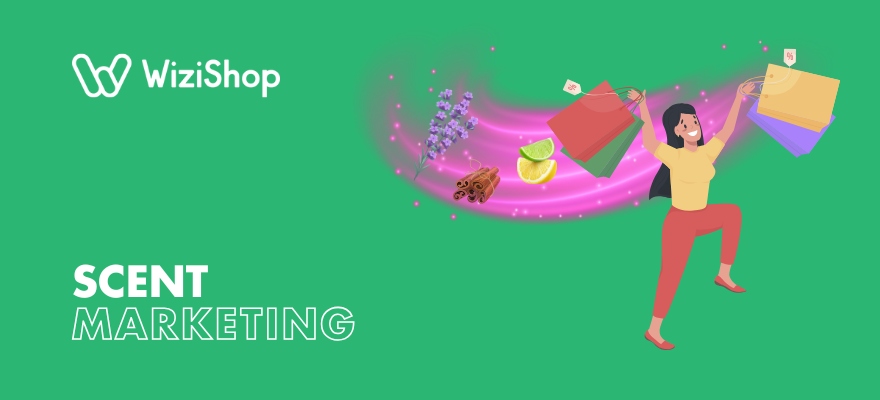In this article, you’ll discover the following:
- Scent marketing is a powerful strategy that uses fragrances to help shape perceptions and emotional connections.
- Various scent marketing approaches exist, including signature scents, thematic, ambient, product-driven, experiential, and functional strategies.
- Scent marketing offers numerous benefits, enhancing customer experience, increasing dwell time, boosting sales, and reinforcing brand identity.
- E-tailers can avail of scent marketing by using scented packaging, samples, direct mail, and more.
- It’s important to select the right scent, ensuring that you align fragrance notes with brand personality, target audience, and desired emotional impact.
Scent marketing is the subtle art of using fragrance to affect mood, shape perception, and enhance brand experiences.
More than just a pleasant aroma, the right scent can trigger memories, inspire emotions, and even drive purchasing decisions.
From retail stores and hotels to ecommerce packaging, brands are finding creative ways to engage customers through their sense of smell.
In this post, we’ll explore how scent marketing works, why it’s effective, and how to use it strategically for your own business.
What is scent marketing?
Scent marketing uses specific fragrances to create emotional connections with customers, enhance brand identity, and influence buying behavior.
It’s a kind of sensory marketing, which is a strategy that targets the five human senses, sight, sound, smell, taste, and touch, to influence consumer perceptions and behavior.
By incorporating carefully chosen scents into physical spaces, be they retail stores, hotels, or spas, businesses can shape how customers perceive their environment and brand.
Scents can trigger memories, elevate mood, and increase the amount of time people spend in a location, often leading to higher sales and stronger customer loyalty.
For instance, a bakery might use the smell of fresh bread to attract passersby, while a luxury store may use a signature fragrance to reinforce a sense of exclusivity.
Scent marketing is subtle but powerful, creating a more immersive and emotionally engaging customer experience that can help brands stand out from their competition.
Olfaction explained: The science behind smell
Olfaction, also known as the sense of smell, is the process by which we detect and interpret airborne molecules through our nose.
When we inhale, scent molecules travel up the nasal cavity and bind to olfactory receptors located on sensory neurons. These receptors send signals to the olfactory bulb, a structure in the brain just above the nasal cavity.
From there, the information is quickly transmitted to other brain regions, notably the amygdala and hippocampus, which are responsible for processing emotion and memory. This direct neural connection explains why certain smells can instantly trigger vivid memories or emotional responses.
Unlike other senses, smell bypasses the thalamus, which is the brain’s typical relay station, and goes straight to areas tied to emotional and long-term memory processing. This unique pathway makes olfaction especially powerful in evoking past experiences and shaping how we feel.
Psychologically, scents can significantly influence mood and behavior. For example, lavender is known to promote relaxation, citrus can elevate alertness, and vanilla often evokes feelings of comfort.
Marketers and therapists use scent strategically to reduce stress, improve focus, or even encourage purchasing behavior.
Consider the following: Blue Tree Aroma reports that Nike, one of the world’s leading sportswear brands, conducted a notable study on retail scenting that delivered striking results. After introducing a signature fragrance into their stores, sales rose by 15%. The study also revealed that customers perceived a pair of shoes to be worth 20% more when a pleasant scent was present.
Different ways to use scent marketing
If the idea of incorporating fragrance into your marketing efforts has piqued your curiosity, here are a few effective ways to do so, noting that several of these strategies can be used simultaneously.
Signature scent branding
Are there any fragrances that with one whiff can make you instantly think of a specific company?
Behold the power of signature scent branding, the use of a unique, custom-designed fragrance to represent a brand’s identity.
It creates a consistent sensory experience that customers associate with the brand, enhancing recognition, emotional connection, and loyalty. This subtle yet powerful tool sets the brand apart and reinforces its personality through scent.
For example, hotel chain Westin’s “White Tea” scent used in their suites has become so beloved by guests that the scent is now available for purchase.
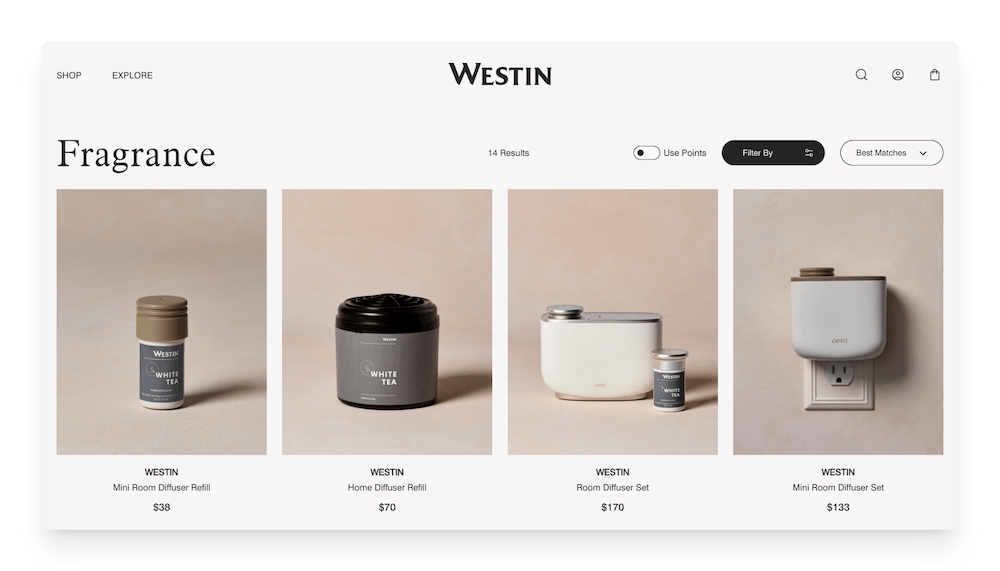
Source: Marriott
Ambient scent marketing
With ambient scent marketing, a brand will subtly diffuse pleasant, non-intrusive fragrances in a space to enhance the overall customer experience, creating a welcoming atmosphere, influencing mood and behavior, and encouraging longer visits.
The company can help build positive emotional associations with the brand by engaging the sense of smell.
Take, for instance, luxury car company Rolls-Royce. The brand is known to subtly infuse the interior of its showrooms and cars with a scent that mimics the leather aroma of their vintage models, triggering nostalgia and luxury cues.

Source: Rolls-Royce Motor Cars Dallas
Thematic scent marketing
Scents can also be strategically used in alignment with a specific season, holiday, or promotional campaign to bolster seasonal promotions or temporary marketing events..
By matching fragrances to a theme, such as pumpkin spice in autumn or pine at Christmas, brands create immersive, time-specific atmospheres that enhance emotional engagement, reinforce marketing messages, and encourage customer participation.
Department store chain Bloomingdale’s is recognized for tailoring thematic scents to specific departments, enhancing the shopping experience for targeted product areas: swimwear sections may feature a coconut aroma, lingerie areas a lilac fragrance, and infantwear departments a soft, powdery scent.
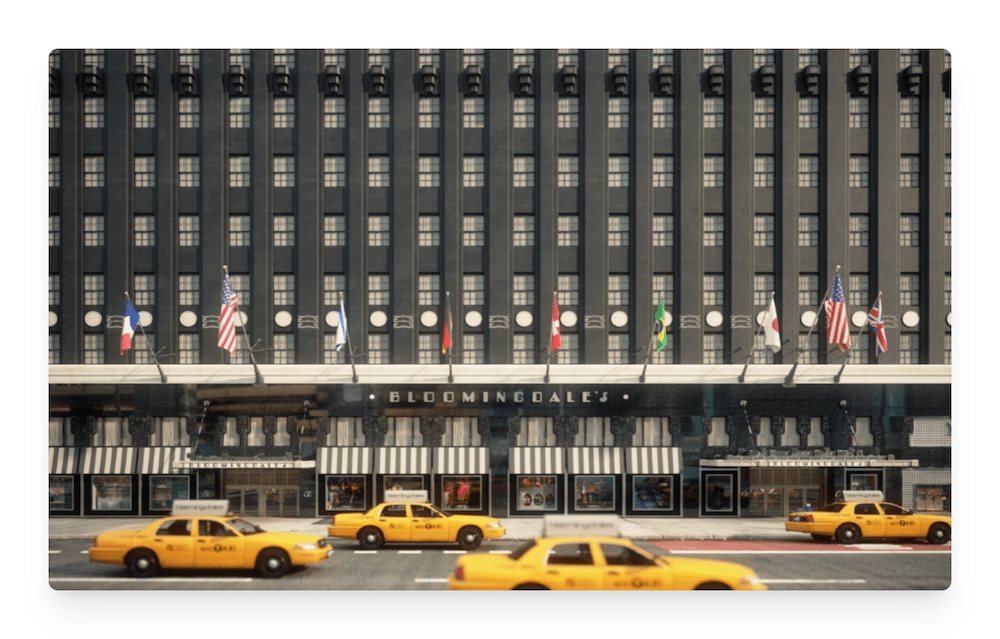
Source: Bloomingdale’s
Product-driven scent marketing
Sometimes scent marketing is just as much about promoting a company’s products as it is about adding to the shopping experience.
In this case, brands will focus on enhancing or highlighting the natural scent of a product to attract customers and influence purchasing decisions. This creates a sensory connection between the customer and the product, making it more appealing and memorable.
Starbucks is a great example: its stores are intentionally designed to emphasize the rich aroma of freshly brewed coffee, which not only entices customers but also reinforces its brand identity and the quality of its offerings.
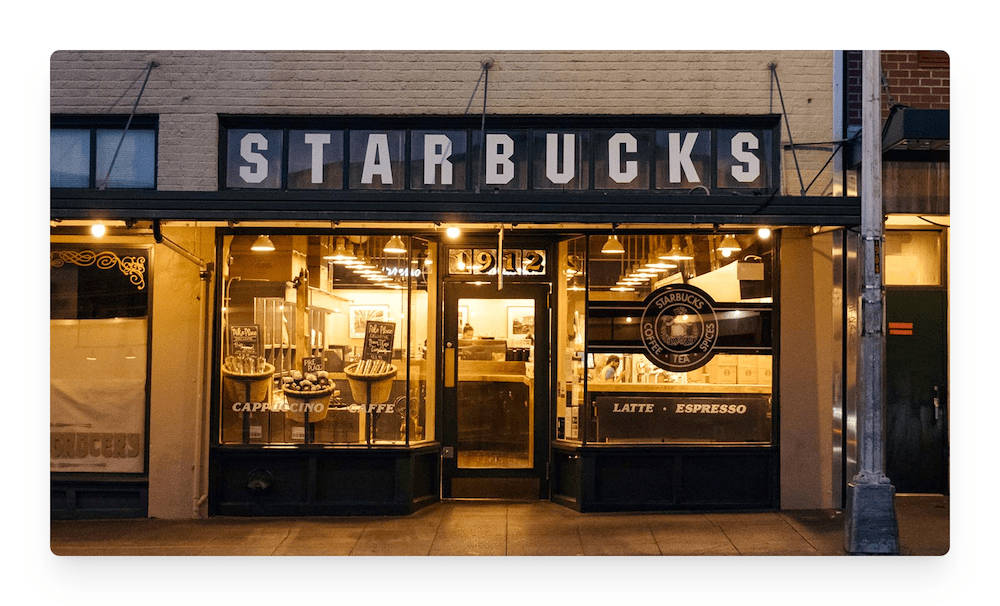
Source: Starbucks
Experiential scent marketing
Another excellent way to make use of scents is to use fragrance to create immersive, memorable brand experiences that engage customers on an emotional level.
Rather than simply masking odors or matching themes, it tells a sensory story, aligning with a brand’s identity or event narrative, so the scent becomes part of the overall experience, deepening connection and recall.
Get inspired by haircare brand Herbal Essences, which deployed “scent-filled domes,” referred to as #pleasurebombs, across Sydney, Australia, inviting passersby to walk into immersive glass structures and experience rich, brand-specific fragrances firsthand.
This unexpected sensory engagement created a memorable and playful encounter that dramatically heightened brand immersion.
Source: Herbal Essences
Functional scent marketing
Functional scent marketing is the intentional use of fragrances to serve a practical purpose beyond atmosphere, such as masking unpleasant odors, signaling cleanliness, or boosting alertness.
These scents directly support functional goals, like citrus to suggest freshness or peppermint to enhance focus, while subtly influencing customer perception and behavior.
With Singapore Airlines, fragrance is beneficial for branding and is practical as well. Their signature cabin scent not only reinforces brand identity but also helps mask stale air and create a fresh, clean perception during long flights.

Source: The Telegraph
Benefits of scent marketing
Wondering if it’s worth developing a stellar olfactory-infused experience for shoppers? Here are some of the benefits that scent marketing can bring to your business!
- Enhances customer experience: A pleasant scent can transform a routine visit into a memorable experience, delighting the senses and setting a positive tone. It’s a subtle touch that makes customers feel welcome, relaxed, and more engaged.
- Increases time spent in-store: A captivating fragrance encourages customers to linger longer, soaking in the atmosphere (and maybe spotting a few more must-haves). The more time they spend enjoying the space, the greater the chance they’ll make a purchase.
- Boosts sales and conversion rates: Scents can trigger positive emotions and create a feel-good environment that nudges customers toward buying. When people feel good, they’re more likely to open their wallets… An enjoyable aroma can help seal the deal!
- Strengthens brand identity through signature scents: Just like a well-crafted logo, a signature scent is instantly recognizable and uniquely yours. It creates a consistent brand atmosphere that customers come to associate with your business on a sensory level.
- Improves brand recall and emotional connection: Smell is the sense most closely tied to memory, making scent marketing a powerful tool for long-lasting impressions. A familiar fragrance can instantly transport customers back to your brand, building loyalty through emotion.
How to use scent marketing in ecommerce
While scent marketing is often employed by brick-and-mortar stores to attract shoppers, it’s not as common in ecommerce.
This is simply because, as efficient as computers and smartphones are, technology has yet to evolve enough to make it possible for scent to waft through a screen.
Ecommerce is more focused on visual aspects, like high-quality product photos and videos, with sound also sometimes playing a role, such as with the addition of music or sound effects.
That being said, you can still harness the power of scent marketing when selling online with several key strategies!
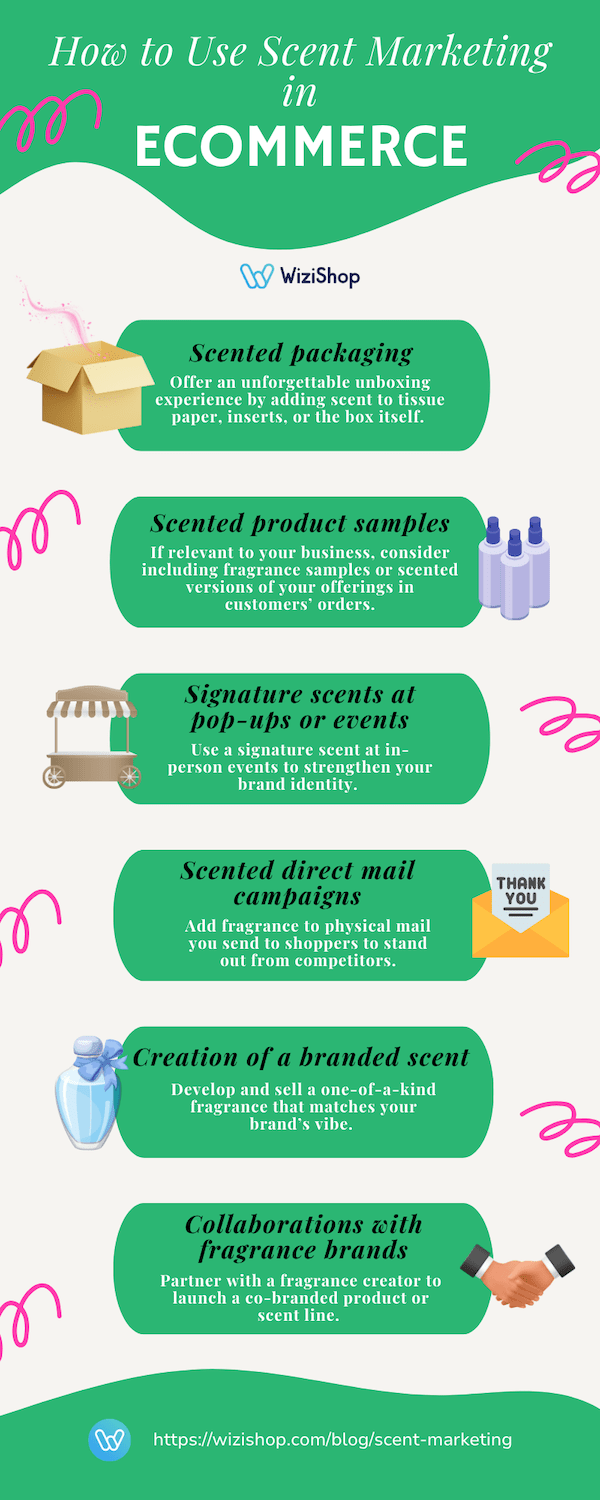
Scented packaging
Creating a memorable unboxing experience is a great way to delight your customers and encourage them to order from you again in the future.
Adding scent to your packaging can aid in making this experience all the more enjoyable, engaging the senses and leaving a lasting emotional impression.
Include a subtle fragrance that shoppers can discover as they open their packages, such as scented tissue paper, inserts, or even the box itself.
Scented product samples
Another effective strategy to use scent in your marketing efforts is to include fragrance samples or scented versions of your products (if relevant) with orders.
Of course, this tactic won’t be relevant for every ecommerce business, but it can work especially well for brands in beauty, wellness, fashion, or lifestyle niches.
Signature scents at pop-ups or events
While some e-tailers operate strictly online, others opt to mix it up from time to time and head to in-person gatherings to connect with current and potential customers alike as well as expand their network.
If your ecommerce brand participates in offline activations, like pop-up shops or trade shows, consider using a signature scent to reinforce your brand identity and stand out—nothing overpowering, but a pleasant fragrance that will make people happy that they stopped by to chat!
Scented direct mail campaigns
Even if most of your communication takes place online, be it through social networks, blog posts, or email newsletters, sending old-fashioned snail mail occasionally can further strengthen your connection with customers.
Add a scent to your postcards, catalogs, or thank-you cards to differentiate your sendings from those of your competitors.
What’s more, this tactile and olfactory element can boost engagement and recall compared to standard marketing mail.
Creation of a branded scent to sell
Depending on what you sell, creating your own branded scent may be an interesting idea for your company.
Some brands develop, for instance, a signature candle, room spray, or perfume that reflects their brand’s lifestyle and aesthetic.
This creates an emotional brand extension and turns scent into a product in itself.
Collaborations with fragrance brands
Finally, there’s no reason why you need to go the 100% solo route when it comes to your scent marketing strategy!
Think about teaming up with a fragrance creator to develop a co-branded product or scent line, blending scent marketing with influencer or product marketing.
Tips on using scent marketing for your business
Before you get to work on crafting your future fragrance-inspired campaigns, consider following these tips to boost your chances of success.
Choose the right scent
In order to pick the best scent for your scent marketing strategy, you’ll need to consider your brand identity, target audience, and the emotional response you want to evoke.
The fragrance should complement the environment, match the desired mood, and align with the cultural preferences of your customers.
Remember to test for subtlety, as overpowering scents can cause discomfort.
Here are a few popular scents and what they tend to be used for to inspire you:
- Lavender: relaxation, stress relief
- Citrus (lemon, orange): freshness, cleanliness
- Vanilla: warmth, comfort
- Peppermint: alertness, energy
- Jasmine: romance, luxury
- Cedarwood: grounding, sophistication
Consider how you’ll disperse the scent
When using scent marketing, how you disperse fragrance is as important as the scent itself.
Options include HVAC scenting for large, consistent coverage, standalone diffusers for targeted zones, and scent machines or candles for smaller, intimate spaces. The right method depends on your location size, desired intensity, and budget.
High-traffic areas benefit from HVAC systems, while experiential zones may use localized diffusers to create focused scent “moments” without overwhelming the entire environment.
Follow best practices when it comes to using fragrance
You may be excited to try out your new scent marketing tactics, but beware of going overboard!
To ensure a positive customer experience, aim to keep scents subtle, so they enhance rather than dominate the environment. It’s also important to maintain consistency in fragrance strength and quality to reinforce brand identity.
Finally, be sure to avoid overpowering aromas, which can cause discomfort or alienate sensitive individuals.
The goal is a balanced, pleasant scent presence that blends naturally into the space, gently influencing mood and behavior without drawing conscious attention to itself.
Think about partnering with a scent marketing company
While you can certainly take a DIY approach to scent marketing for your business, you might alternatively want to consider working with a scent marketing company to help ensure that your fragrance strategy is both effective and brand-appropriate.
These experts can design custom scents that align with your identity, advise on optimal dispersal methods, and ensure regulatory compliance. They also handle installation, maintenance, and scent intensity calibration.
By leveraging their expertise, you can create a consistent, high-quality scent experience that avoids common pitfalls, e.g., mismatched aromas or overpowering diffusion, while maximizing emotional impact and customer engagement.
Employing fragrance in marketing: A scent-sational idea!
Scent marketing isn’t limited to physical spaces… It can thrive in ecommerce with a little bit of creativity.
While online shoppers can’t smell your store, you can integrate scent through scented packaging inserts, sample vials, or limited-edition products tied to seasonal fragrances.
These tactile touches bridge the sensory gap, leaving a memorable impression that builds emotional connection and brand loyalty.
Whether in-store or online, the right scent has the power to spark memories, shape perceptions, and influence behavior, making it a versatile and impactful tool in any marketer’s arsenal!


